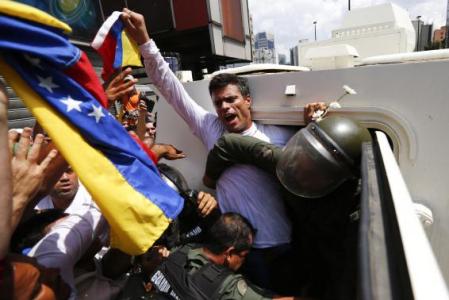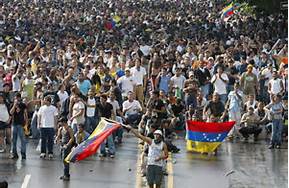Venezuela’s financial contribution to Cuba is $13 billion a year. Most of the oil Maduro sends to Cuba is sold for dollars in the international market. If Venezuela overthrows the communist government using the “Guarimba” and with a sustained general strike paralyzing the nation, Cuba could be next. Obama can bring the end of communism in both nation by declaring a complete embargo on Venezuela and refusing to buy any oil. Of course, he is not going to do it.
Opposition marchers that ranged from students to middle-aged professionals and senior citizens filled a square and major avenues in the east of Caracas to protest problems including 56 percent annual inflation and one of the world’s highest murder rates.
The unrest evolved from sporadic regional protests into nationwide movement after three people were shot dead following a February 12 march. At least 17 people have been killed at the hand of police and Cuban military forces infiltrated in Venezuela. This has been the South American nation’s most violent unrest in a decade. The people of Venezuela are using the “Guarimba” to remove the dictatorship of President Maduro.
The “guarimba“, in the simplest sense, is a makeshift barricade, partially a (well-justified) defense against the paramilitary police units and violent pro-government motorcycle gangs, partially an area-denial measure, and partially a very visual statement of defiance. On the tactical level, the word also refers to the methods of using the barricades to their maximum effectiveness. It is pacific resistance, sustained and long term mass demonstrations.
Guarimbas are usually erected at an intersection, in order to block traffic and provide residents with advance notice if government troops are coming. Guarimberos (people who build the guarimbas) usually live near the barricade, so they can observe its status from a safe distance, and quickly rebuild it if the government troops manage to take it down or clear a passage. The latest information from Venezuela, indicate that the people are using their cars to block the streets.
The DiccionarioLibre website offers this explanation of “guarimba”:
Guarimba or Location shelter, preferably one’s residence, building or complex, which is used for non-violent mass demonstrations, mass demonstrations are held without confrontation with violent government henchmen. Barricades are setup in the streets in front of peoples houses, not more than 150 feet, with whatever is available to obstruct the traffic and shut down and paralyze the city and eventually the entire country. This leaves the government without power, forcing him to cease to function. The barricades are setup again and again, even if they are dismantled. At the extreme, cars are placed in the streets to prevent the government from reaching peoples homes with heavy military equipment to quell the protests.
The Guarimba is a modified non-violent mass protest established by Robert Alonso in Venezuela. The originator of the art of non-violent action was Dr. Gene Sharp. In his book and articles, Gene Sharp discusses the nature of political power and how change can be brought about through the use of strategic nonviolence. In his article on the power of nonviolent action, Sharp relates several historical episodes, including the American Revolution, where nonviolent action played a pivotal role in achieving political change.
The government of Venezuela is aided by the Communist government of Cuba and has military agents in every sector of the Venezuelan government. The following article provides background information on why Cuba is involved in Venezuela.
The Latell Report February-March 2014
The Latell Report analyzes Cuba’s contemporary domestic and foreign policy, and is published periodically. It is distributed by the electronic information service of the Cuba Transition Project (CTP) at the University of Miami’s Institute for Cuban and Cuban-American Studies (ICCAS).
|
Cuban Strategy in Venezuela |
Last Sunday Raul Castro set out the essence of Cuban policy toward the increasingly volatile situation in Venezuela. Speaking to the Cuban labor confederation he described it as “a complex crisis,” indicating considerable alarm in Havana about how Cuba’s vital economic and security interests might be affected.
Memories of the outcomes of three earlier crises in Caribbean and Latin American countries tightly allied with Cuba must be worrying Raul and others in the leadership.
- In September 1973 Salvador Allende was overthrown in Chile in a savage military coup as the Marxist upheaval that he led for three years in a partnership with Fidel Castro ended. Allende’s death in the coup was a devastating blow to Cuban prestige and a significant personal loss for Castro. Allende was wearing a bulletproof vest and carrying a submachine gun Fidel had given him when he committed suicide in the presidential residence.
- Ten years later in tiny Grenada, Cuban ally Maurice Bishop was the victim of a surprise coup that installed the more radical Cord-Austin regime in power. But Bishop was executed by a firing squad, along with a number of his supporters, giving rise to chaos and an American military intervention supported by several other Caribbean states that restored democratic rule. Bishop had been particularly close to Fidel Castro, an adoring acolyte. His death was another serious blow to Cuban aspirations for leadership among third world and developing nations.
- In 1990, the closest of all the Cuban allied regimes was turned out of office in democratic elections. Daniel Ortega and his Sandinista revolution, tied inextricably to Cuba since the 1960s, had lost. Of the three regional disasters for Cuban influence, this was the most punishing for Havana.
But none of these calamities for Cuba compares to the enormity of the possible loss of Venezuela if the Bolivarian revolution loses power as a result of the massive demonstrations and unrest that has buffeted the country for two weeks now. Cuba receives enormous financial and other forms of assistance from Caracas, amounting recently to as much as $13 billion annually according to respected economists.
It is not surprising then, that Raul expressed full support for Venezuelan president Nicolas Maduro, praising his “intelligence and firmness in the way he has handled” the crisis. Raul gave assurances of Cuba’s “full support for the Bolivarian and Chavista revolution and compañero Nicolas Maduro.”
Siding unmistakably with the brutal tactics of the Venezuelan security forces, Raul condemned “energetically” the “violent incidents unleashed by fascist groups” in Venezuela, “causing deaths and scores of injuries.” He implied that the United States was supporting the anti-government demonstrators and might even consider intervening.
It is not surprising that Cuba is unequivocally backing its man in Caracas. Maduro, after all, was the Cuban regime’s choice to succeed Hugo Chavez after his death a year ago. Maduro appeared at the time to be the best candidate, well known to Cuban intelligence and diplomatic officers, and considered to be a thoroughly reliable ally. The likely concerns they had about Maduro’s abilities and qualifications were put aside.
But how long will Havana support him? Maduro’s leadership has come under increasing pressure as protests have intensified. He has made a number of laughable blunders. The governor of Tachira state criticized Maduro’s handling of demonstrations in his state, a stronghold of anti-government sentiment. More importantly, the governor for years has been a close ally of assembly president Diosdado Cabello, considered Maduro’s principal rival in the Bolivarian leadership.
Raul Castro and his numerous emissaries in Venezuela are unlikely to stay indefinitely behind Maduro if his standing sinks to anything close to an untenable situation. The Cuban stake in receiving continued Venezuelan largesse is so great, that Raul will likely do whatever seems necessary to keep the spigot open. If that meant moving with Venezuelan military and other allies to dump the president under some pretext, he would be the victim of cold Cuban calculation.
But such a decision would be fraught with risks. Would Cabello, or some other anointed successor, prove to be as reliable an ally? Would a Cuban-engineered coup arouse even greater opposition in the streets, and possibly in the Venezuelan military? Anecdotal reports of mounting popular animosity toward the large Cuban presence in Venezuela are being heard more often.
If opposition protests continue, and adverse trends persist, will the Bolivarian revolution survive? If not, the damage to the Cuban economy will be devastating—though probably not as terrible as when Soviet assistance was terminated. How then would Raul Castro’s government deal with such a crippling crisis?
_____________________________
Brian Latell is the author of Castro’s Secrets: Cuban Intelligence, the CIA, and the Assassination of John F. Kennedy (Palgrave Macmillan, 2013). A former National Intelligence Officer for Latin America, he is now a senior research associate at the Institute for Cuban & Cuban-American Studies, University of Miami.
________________________________
.


